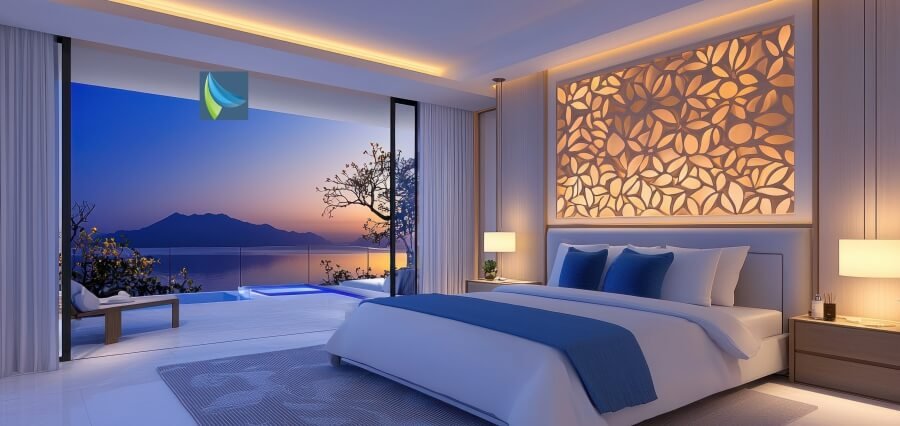Class Apart
The decade witnessed a spectacular revolution in the home furnishings and interior design scene in India. With increasing disposable incomes, increased international exposure, and increasing sensitivity to aesthetics, luxury decorating in India is a newly born industry. Luxury interior design, the exclusive preserve of royalty and upper classes just a few years ago, increasingly falls within the reach of a broader cross-section of society, even the urban high-income group. The quest for improved interior space, individually tailored and elitist, has brought with it a new era of elegance and sophistication to Indian interiors.
Indian luxury is not decadent frivolity but an issue of lifestyle that harmoniously balances comfort, practicality, and sensibility. Indian luxury consumers are more discerning by the day, prioritizing craftsmanship, heritage, and global style. This resulted in the expansion of high-end furniture brands, bespoke decor firms, and global-name designers who now enjoy a growing client base in India. While Mumbai city, Delhi, Bengaluru, and Hyderabad continue to see a boom in luxury realty developments, the luxury interiors industry also experienced an uptrend simultaneously. Luxury furniture components are now being introduced by contractors right at the beginning of housing projects, providing fit-out, fit-to-finish fit-out with complete furnishing extravagantly, fulfilling the needs of new-generation Indian buyers. Luxury interior in India has been spurred by one of the greatest stimuli, and that is the globalisation of taste.
Indian buyers are now highly travelled and exposed to global design trends. This has led them to want living spaces that reflect their global lifestyle with ties to culture. This has led developers to import fit-out, fit-to-finish fit-out with completed furniture in abundance. This convergence has created a revolutionary design story that combines centuries-old Indian skill and contemporary minimalism or luxury European. Talented crafts men with skills of the past era of hand-carving, inlay and weaving are gaining new significance in this luxury business. Brands are increasingly collaborating with such crafts men to develop products which are rich in their cultural heritage as well as in the global world, coveted, thereby giving shape and meaning to luxury interior design in India. Technology-enabled personalization of space is another major trend driving luxury interior design development in India.
Automated lighting, temperature control, security systems, and voice control are no longer the tomorrow that it seemed yesterday but are already today’s reality. Luxury interior design these days is all about intelligent design and aesthetic appeal. Owners are investing in bespoke furniture, carefully curated collections of art, and inbuilt lights to create unique ambiances that reflect their uniqueness. Technology has facilitated designers to design and implement ideas well, further driving the luxury home interior of Indian residences. Input of foreign luxury firms cannot be excluded in the increasing demand for luxury home furnishings in India.
Hemi brands like Fendi Casa, Roche Bobois, Armani Casa, and Versace Home have spread their arms to India in order to make Indians who spend a lot available for designs globally. These brands typically partner with Indian fashion designers and retailers to translate their products into native taste and sensibilities. Not only did they enrich customers’ options but also the quality and creative scale of the entire design of Indian home furnishings. At the same time, new generation luxury home furnishing firms have joined the fray, blending native materials with modern design philosophy. Sustainability is the other aspect more intrinsically embedded in the story of Indian luxury home furnishings.
Green consumers do not demand just high-end and luxurious products but also products that are produced ethically and sustainably. This has developed the concept of eco-luxury in interior design, with an emphasis on sustainable materials such as bamboo, reclaimed wood, organic textile, and low-impact dyes. Designers are gravitating towards circular design, and timelessness and longevity in design are preferred. The trend is indicative of an abiding, values-driven understanding of luxury that is associated with sustainability in the environment and sustainable consumption. India has a promising future for luxury home decor due to both market opportunity and cultural diversity.
Industry places the estimate of the growth of India’s home furnishing luxury homes business at more than 7% compound annual growth rate (CAGR) in the next five years. Growing upper-middle class, growing urbanization, and sustained real estate and infrastructure investment will drive the growth. Besides, the role of internet media and social media will also facilitate the extended outreach and influence of luxury home trends to help brands reach aspirational consumers in Tier II and Tier III cities. Above all, even the word “home” has also gone through a fundamental shift in the post-pandemic world.
As all are staying home and spending more time indoors, home renovation and customized living are emerging as a priority. Home owners will be making an investment in Indian luxury home furniture that is extremely comfortable, healthy, and provides a haven-like feel. Wellness-focused design like interior landscapes, spa bathrooms, ergonomic furniture, and soothing colors are on the rise, putting higher value on luxury in India. The contribution of cyber portals, architects, and design influencers also cannot be downplayed in shaping the direction luxury decor development is taking in India.
Instagram and Pinterest are being employed as inspiration boards by millions now, since digital monsters and bespoke luxury websites render luxury decor within your reach with a click. This virtual revolution has democratized luxury to some extent, and one can now shop around and invest in decor pieces as an extension of one’s imagination, beyond geography. Thus, Indian luxury decor has graduated from being a niche to a colorful and rapidly growing industry.
Luxury decoration is a union of technology and tradition, elitism and affordability, functionality and beauty. As the global influences meet, increasing consumer aspirations, and technology advancements, the future of Indian luxury interior designing is poised to grow steadily. As the trend unravels, it will transform Indian desires and definition of luxury in the personal domains of the home—repositioning it as a symbol of success but also an expression of self, culture, and aspirational lifestyle.

